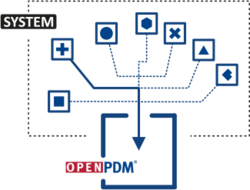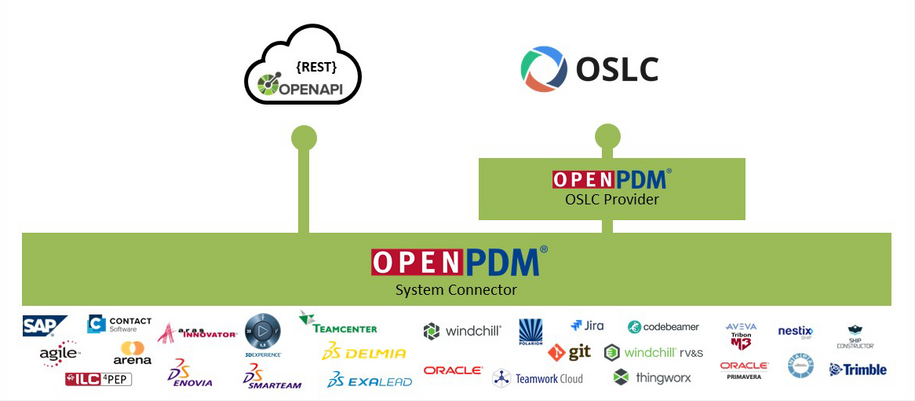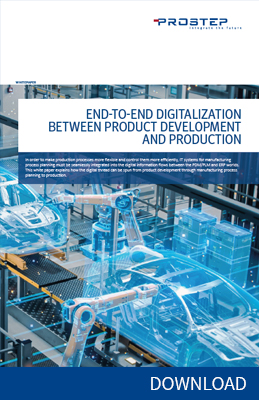Your contact

Mirko Theiß
OpenPDM system connectivity
OpenPDM connectors provide unified access to the systems in your PLM landscape. OpenPDM connectors ensure that up-to-date product data is always available within your development processes and can be processed consistently.

Within the OpenPDM platform, the connectors provide a unified interface for reading/writing the relevant information from/to the connected PLM systems.
OpenPDM connectors always use the officially released API from the respective PLM system vendor, which means that all the concepts relating to security, people and organization, and customization are taken into account. In addition to the standard data model provided by the PLM system, the connectors can read and write all object types derived from this model. Customer-specific attribution can of course also be processed.
The OpenPDM connectors can also be used independently of the OpenPDM Integration Platform, for example to establish system connectivity in your existing environment. Here, they offer the advantage that they can access all PLM systems via a unified REST interface. Different interfaces to the systems are thus a thing of the past.
Typical use cases where OpenPDM connectors support you
- Reading and writing product data from systems that are required for an end-to-end digital thread
- Developing a best-of-breed PLM system architecture to provide optimum support for the PLM domains
- Harmonizing data when different ways of working and different processes in the PLM domains are used
- Connecting PLM systems to existing integration platforms
- Extending a company's own software systems to include access to a variety of different PLM systems
Functions and services provided by OpenPDM connectors
OpenPDM connectors are independent microservices and provide a unified interface for reading and writing data in the connected systems. The following functions and services are supported by all OpenPDM connectors:

- Fast and reliable system integration instead of extensive and costly in-house development
- Unified REST interface for all connectors based on the OpenAPI/Swagger standard
- Generic unified interface for all the connectors
- Fine-grained reading on object, relation, file and attribute level
- Fine-grained writing/updating on object, relation, file and attribute level
- Complex automatic reading of complete hierarchical structures starting at a root node
- Complex automatic writing of complete hierarchical structures starting at a root node
- Calling workflows and processes in the connected PLM systems
- Easy expansion possible while maintaining the quality of the interface
- Generic unified data model for all connectors
- with XML- and JSON-based schema
- Support for the standard data model in the PLM systems
- Unterstützung kundenangepasster Datenmodelle der PLM Systeme
- Web-based administration user interface for configuring the connector and import/export behavior
- Authentication based on Basic Auth or OpenID standards that can be configured separately in the frontend and API context
Adaptable logic for reading and writing the data
When writing and reading data in the target system, you can choose from a catalog of behavior patterns, as the so-called export and import strategies. These behavior patterns are tailored to the business rules of the respective PLM system. Behavior when writing an object, for example, can be defined and evaluated at attribute level object. This makes it possible to decide with a very fine level of granularity whether an object is updated in the same version or whether a new version needs to be created.
Copying and linking information
Depending on the application scenario involved, PLM data has to be copied or linked between the connected systems. OpenPDM connectors make both use cases possible for all the connected systems.

As stated earlier the OpenPDM connectors' REST-based OpenAPI/Swagger interface makes all the product data from a PLM system available in a unified manner and can process not only complex product structures but also work with a fine level of granularity at object and attribute level.
The OpenPDM OSLC Provider makes the data available in line with the OSLC standard for every OpenPDM connector. This makes it possible to integrate any system for which an OpenPDM connector exists in your system landscape according to the OSLC process model and to link the information between the systems. The OpenPDM OSLC Provider provides the data via the OSLC REST interface but also via delegate user interfaces.
List of available standard connectors
OpenPDM can connect all systems that provide a defined programming interface. Even if PROSTEP does not yet offer a standard connector to your system, a connection can be established quickly and easily using the OpenPDM connector template.
OpenPDM offers ready-to-use standard connectors for the following systems, among others. Other systems are available on request.
- Aras Corp. – Aras Innovator
- Arena/PTC– Arena PLM
- Atlassian – Jira
- Autodesk – Vault
- AVEVA – AVEVA Marine
- Cadmatic – CADMATIC
- Contact – Contact Elements / CDB
- Dassault Systèmes – 3DEXPERIENCE
- Dassault Systèmes – Cameo Cloud
- Dassault Systèmes – Exalead
- Dassault Systèmes – SmarTeam
- Diverse – GIT
- Hexagon – Nestix
- ILC Solutions – 4PEP PLM
- MongoDB – MongoDB
- Napa – Napa
- Oracle – Agile e6
- Oracle – Primavera P6
- PTC – Codebeamer
- PTC – Windchill
- PTC – Windchill RV&S (Integrity LM)
- PTC – Thingworx
- SAP – SAP PLM
- Siemens PLM – Teamcenter
- Siemens PLM – Polarion
- SSI – Ship Constructor
- Trimble – Nova

